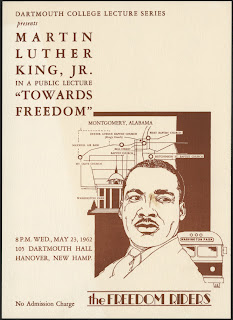 On May 23, 1962, Martin Luther King Jr. spoke to an overflow crowd in 105 Dartmouth Hall. His speech, "Towards Freedom," was part of Dartmouth's famed Great Issues course.
On May 23, 1962, Martin Luther King Jr. spoke to an overflow crowd in 105 Dartmouth Hall. His speech, "Towards Freedom," was part of Dartmouth's famed Great Issues course.But it wasn't so simple to get King to campus. He had agreed to speak at a Union service on May 15, 1960, followed the next day by a question/answer period with the Great Issues class. On April 5th, he wrote to cancel his visit because of a pending income tax case in Alabama. He rescheduled for May 21, 1961. This time he made it to campus, but was forced to leave town the morning of the talk upon hearing reports of racial unrest in Alabama. On May 23, 1962, he was finally able to deliver his address. According to accounts in The Dartmouth, he warned idealistic students to be wary of the "myth of educational determinism." Education alone could not solve the problem, the law was still necessary to regulate behavior. He ended with a call for President Kennedy to issue a second Emancipation Proclamation declaring all segregation unconstitutional on the basis of the Fourteenth Amendment.
Learn more about Dartmouth's 2010 celebration of Martin Luther King Jr. Day, "Where Do We Go From Here?"
